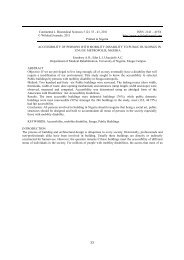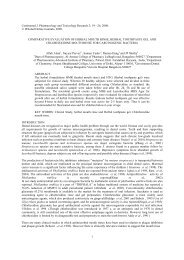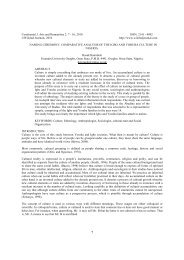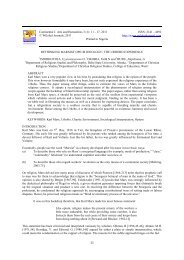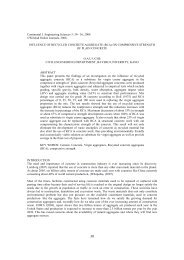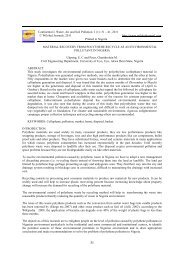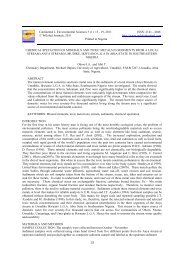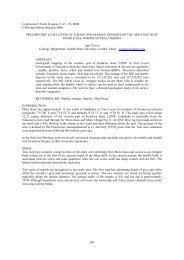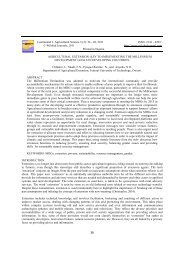Continental J. Sustainable Development 1 - Wilolud Journals
Continental J. Sustainable Development 1 - Wilolud Journals
Continental J. Sustainable Development 1 - Wilolud Journals
You also want an ePaper? Increase the reach of your titles
YUMPU automatically turns print PDFs into web optimized ePapers that Google loves.
<strong>Continental</strong> J. <strong>Sustainable</strong> <strong>Development</strong> 1: 51 - 56, 2010©<strong>Wilolud</strong> <strong>Journals</strong>, 2010http://www.wiloludjournal.comFARMERS’ PROVISION OF FEEDBACK ON FISHERY TECHNOLOGIES IN EPE LOCAL GOVERNMENTAREA OF LAGOS STATE.Oyetoro J.O and Akinboye O.A.Department of Agricultural Extension and Rural <strong>Development</strong>, Ladoke Akintola University of Technology,OgbomosoABSTRACTThe rapid increase in world population has resulted in a huge increase in the need for animal protein and othernutritional requirement. Fish farmers’ face a series of constraints that contribute to their marginal production and theforegoing problems led to the development of fisheries technologies by researchers for onward transmission to thefarmers by the extension agents. Technology development process is describe as one that is participatory because itinvolves end users helping to ensure that research is demand driven rather than supply.Farmers’ participation implies an acceptance that local people can to a large extent identify and modify their ownsolutions to suit their needs. With the support of the researchers and development agents to assist the farmers in theirown effort to change their farming system hence it is a combination of activities. The routine monitoring andcollection of data on the farmers’ situations thus give rise to feedback of different types.Feedback is a way of overcoming the gap between the farmers and research. It is the pattern of relating informationfrom farmers back to the researchers after having received or adopted the innovations earlier disseminated to them.The study was carried out in Epe local government area of Lagos state. A well structured interview schedule wasadministered to a sample of 110 fish farmers randomly selected in the study area. Data was analyzed using bothdescriptive and inferential statistical tools such as frequency counts, percentages and correlation.Considering the age of the respondents, it was clear that majority of the respondents are middle aged and wouldtherefore posses the vitality for providing feedback on fishery technology likewise most of the respondents areeducated which favours feedback provision. Also, majority of the sampled respondents engage in fish farming as anoccupation.Analysis performed on the variables shows that there was a strong correlation between channel of feedback andprovision of feedback on fishery technology (r = 0.690). This implies that the better the channel of feedback, themore the respondents reacts (provide feedback) on fishery technologies.KEYWORDS: Feedback, Feedback channels, Fishery, Fish demand, Technology, Innovation,INTRODUCTIONThe rapid increase in world population has resulted in a huge increase in the need for animal protein and othernutritional requirements. This is particularly crucial in developing countries like Nigeria where there is wideninggap between supply and demand of fish leading to the large scale fish importation. As stated by FAO (1991), fishprovides roughly 40% of the protein intake for nearly 2/3 of the world’s human population.Consequently, the fish industry in Nigeria is an important component of the agricultural sector. The biological roleof fisheries is largely nutritional as in the case of livestock, it helps to sustain the chemical protein, fat, calcium, iron,vitamins and the essential amino acids contents of the body. Also, protein from animals e.g fish are more nutritiousand better utilized by the body than those from plant foods (George, 1992). From socio-economic point of view,fisheries make significant contribution to rural economics in terms of income, employment opportunities, cottageprocessing of fish into fish oil and provision of fish markets. Nigeria’s total fish production accounts for 6.1% ofAfrican’s total catch and 0.32% of the world’s fish harvest (FAO, 1991). Nigeria also obtain foreign exchange fromthe export of fin fish and shell fish, for instance the annual foreign exchange from shrimp stands at about 200million dollars. The Nigerian fisheries sub-sector consist of artisanal industry and aquaculture.51
Oyetoro J.O and Akinboye O.A: <strong>Continental</strong> J. <strong>Sustainable</strong> <strong>Development</strong> 1: 51 - 56, 2010Artisanal consist of small scale fishermen that make use of canoes and out board engine while in industrial sector,large trawlers and highly specialized fishing gears are used and aquaculture on the other hand involves the rationalrearing of fish and other aquatic organisms in man-made ponds, reservoirs, cages or other enclosure in lakes andcoastal water bodies (Youdeowei et al, 1995). Fishermen faces series of difficulties that contribute to their marginalproduction. Government fishery policies often tend to concentrate resources in the modern, large-scale, commercialfisheries that earn foreign exchange, thus the small scale fishermen finds it difficult or impossible to obtain credit,extension services, marketing assistance from development programmes.The foregoing constraints led to the development of fisheries technologies by researchers and disseminated byextension agents. The technology development process is described as one that will be participatory, involving usershelping to ensure that research is demand driven rather than supply. Also, that this reversal is essential if appliedresearch is to produce the technologies required to fuel agricultural development. Farmers’ participation implies anacceptance that local people can to a large extent identify problems and modify their own solutions to suit theirneeds whereby outsiders such as researchers and development agents support farmers in their own effort to changetheir farming system, hence the process is a combination of activities and recognizing the important role of farmersof farmers in generating and communicating innovations. Therefore, routine monitoring and collection of data onfarmers circumstances thus gives rise to different forms of feedback (Biggs 1989).Feedback is a way of overcoming the gap between farmers and research. It is a pattern of relating information fromfarmers back to the researcher after having received or adopted the innovation earlier disseminated to them. Also,feedback helps to understand the different constraints to participation faced by men and women and the currentstrategies needed to ensure further participation of both. Moreso, feedback is important because farmers relay theirviews on certain conditions of their farm either of the innovation introduced to them if applicable or not. It ispresumed that the last stage of communication on technology transfer process is feedback and it is important forequity and efficient consideration. Also, it gives the opportunity for strengthening farmers participation in setting theagenda for the future.Similarly, fisheries development programme of the various levels of government in the past failed to make thedesired impact on fish production because their design and implementation lacked adequate extension support. Thedescription of the technology transfer process is a misleading metaphor because farmers non-adoption and abandonadoption of technologies have been ascribed to the failure of farmers to appreciate the benefits of such technologyand the bottleneck in the technology transfer process. Farmers are seen as passive users of technologies andtechnology has been thought of as a single uniform product that is generated by researchers and flow downstream tofarmers in a one way linear process hence farmers’ reaction on technologies in form of feedback are oftenneglected.Moreover, feedback been the most important stage of the process of communication whereby the extension agentsreally evaluate their message whether adopted or abandon by the farmers therefore a proper understanding andorientation of the concept of feedback from the farmers to the extension agents and researchers should not beneglect. In view of this, the study intends to analyse the farmers provision of feedback on fishery technology,identify the demographic characteristics of the respondents and to identify the types of feedback given by therespondents and its frequency of use. It was also hypothesized that no significant relationship exists betweenfeedback channels and feedback provision on fishery technology.METHODOLOGYThe study was conducted in Epe Local Government Area of Lagos. It lies approximately 40km north of Lagos Stateand it is located between longitude 2 0 0 0 and 4 0 30 0 east and latitude 6 0 20 0 and 6 0 40 0 of the equator. Conveniently,it can be concluded that Epe Local Government Area of Lagos State is one of the major areas where Lagos state gether food supply due to different agricultural practice like crop production, livestock production and fisheries whichare the order of the day in the local government area.Epe Local Government Area of Lagos State is well known for its bubbling fishing activities because of itsnumerous water bodies and its fishing villages includes; Erepoto, Ebute Afuye, Okorisan and Igboye. The52
Oyetoro J.O and Akinboye O.A: <strong>Continental</strong> J. <strong>Sustainable</strong> <strong>Development</strong> 1: 51 - 56, 2010population of study consists of all farmers involved in fish production in the study area both males and females. Thelist of farmers involved in fish production was provided by the zonal office of the Lagos State ADP and below arethe numbers of fish farmers in the area that constituted the study area.Erepoto 20Ebute Afuye 74Okorisan 30Igboye 05Total 129Eight-five percent of the total fish farmers’ population constituted the sample size thusErepoto 20Ebute Afuye 60Okorisan 25Igboye 05Total 110Primary data was used for the study. It was collected with the aid of structured interview schedule. Descriptivestatistics like frequency and percentage was used in measuring some selected variables while the inferential statisticused to test the hypothesis was Pearson Product Moment Correlation (PPMC). The dependent variable wasprovision of feedback on fishery technology which was measured by type of feedback and scored accordingly.RESULTS AND DISCUSSIONDemographic characteristics of the respondentsTable 1 shows the age of fish farmers ranges from 21-67 years. Most of the farmers involved in fish production arebelow the age of 30years (56.4%). This implies that they are middle aged and hence possess vitality for fish farmingactivities because they will be more adventitious and hence can take risk unlike other farmers who are so committedto the conventional agricultural practice. The table further reveals that 86.4% of the total respondents sampled weremale while the remaining 13.6% were female. This implies that men are the one who tend to engage in fish farmingmostly while their female counterparts are mostly involved in processing and other post harvesting activities. Also,less female involvement in fish farming can be attributed to time spent on other activities especially householdchores and caring for the children.Marital status influences certain decisions in agriculture and compliment labour availability. It can be observed onthe table that 28.7% of the sampled respondents are single while the highest percentage accounted for marriedrespondents (43.6%) and 13.9% were widowed. This indicates that the married have extra hands to work with ontheir farms hence can embark on more farming activities. Most of the farmers involved in fish farming belong to onesocial group or the other. Forty-three percent of the respondents belong to one social group or the other while34.8% accounted for those respondents who do not belong to any social association.Similarly, majority of the respondents (56.4%) are educated which is expected to favour feedback provision while26.1% accounted for those respondents who have no formal education. This is in line with Ogunfiditimi (1981) thata positive and significant correlation exists between literary level and farmers’ use of recommended practices. Itcould also be seen that majority of the fish farmers in the study area (58.2%) engage in fishing as their primaryoccupation while the remaining 41.8% engage in fishing as their secondary occupation. These respondents practicefishing mostly because their areas lie within a riverine lakes and reservoirs which contributed immensely to fishingin the study area.Data presented on Table 2 shows that 25.2% of the respondents regularly provided question asking as suitable typeof feedback use while 11.3% rarely provided this as suitable for their use. Also, 21.7% of the sampled respondentsregularly provided the use of observation as their type of feedback while 17.4% accounted for those respondentswho rarely thought of observation as their type of feedback use. Moreso, 21.7% of respondents regularly provided53
Oyetoro J.O and Akinboye O.A: <strong>Continental</strong> J. <strong>Sustainable</strong> <strong>Development</strong> 1: 51 - 56, 2010suggestion as their type of feedback use while the remaining 14.8% of the respondents rarely provided suggestionas their type of feedback usage, likewise 21.7% of the respondents regularly provide criticism as their type offeedback use while 7.8% rarely required criticism as their feedback type.Further analysis reveals that 18.3% of the farmers involved in fish production provided commendation as theirregular type of feedback use and 13.9% of the fish farmers rarely accept thus as their feedback use. Twenty percentof the respondents provided advice as their regular type of feedback use while 7.8% rarely accepted thus as theirtype of feedback use. It can therefore be seen from the table that question is greatly provided as a type of feedbackuse while commendation was least provided as type of feedback use.It could be observed from Table 3 that 31.8% of the respondents provided feedback through mass media channelswhile 68.2% uses Extension Agents as channel to provide feedback. This implies that majority of the respondentsmake use of Extension Agents to express their reactions towards fishery technologies passed across to them.Hypothesis testingData presented on Table 4 shows that the channel of feedback used exhibit a larger r value of 0.690 at P
Oyetoro J.O and Akinboye O.A: <strong>Continental</strong> J. <strong>Sustainable</strong> <strong>Development</strong> 1: 51 - 56, 2010Table 1: Frequency distribution and percentage of respondents according to demographic characteristicsDemographic characteristics Frequency PercentageAge (Years)Less than 30 62 56.430-40 14 12.741-50 01 0.951 and above 33 30.0GenderMale 95 86.4Female 15 13.6Marital statusSingle 33 30.0Married 48 43.7Divorced 16 14.0Widowed 06 5.5No response 08 7.3Social groupYes 50 45.4No 40 36.4No response 20 18.2Level of educationNo formal education 30 27.3Adult education 05 4.5Primary education 25 22.8Secondary education 20 18.2Tertiary education 10 9.1Others 15 13.6No response 05 4.5Primary occupationFishing 64 58.2Non-fishing 46 41.8Source: Field Survey, 2009.Table 2: Distribution of respondents according to feedback type and its frequency of usageFrequency of useType of feedback Regularly Occasionally Rarely No responseAdvice 23*(20.0) 40(34.8) 9(7.8) 38(34.5)Criticism 25(21.7) 37(32.2) 9(7.8) 39(35.5)Commendation 21(18.3) 40(34.8) 16(13.9) 33(30.0)Suggestion 25(21.7) 46(40.0) 17(14.8) 22(20.0)Question 29(25.2) 44(38.3) 13(11.3) 24(21.8)Observation 25(21.7) 44(38.3) 20(17.4) 21(19.0)Others 26*(22.6) 50(43.5) 20(17.4) 14(12.7)* Percentage in parenthesis.Source: Field Survey, 2009.Table 3: Distribution of respondents according to feedback channelsFeedback channels Frequency PercentageMass media through(telephone programmes on radio and TV) 35 31.8Extension Agent 75 68.2Source: Field Survey, 2009.55
Oyetoro J.O and Akinboye O.A: <strong>Continental</strong> J. <strong>Sustainable</strong> <strong>Development</strong> 1: 51 - 56, 2010Table 4: Correlation analysis of the relationship between feedback channel and the provision of feedback on fisherytechnologyVariableCorrelation Significance ratio Decisionvalue (r)Channel of feedback 0.690 0.385 SignificantSource: Field Survey, 2009.Received for Publication: 14/10/2010Accepted for Publication: 22/12/2010Corresponding AuthorOyetoro J.O.Department of Agricultural Extension and Rural <strong>Development</strong>, Ladoke Akintola University of Technology,OgbomosoEmail: preciousfanta@yahoo.com56






